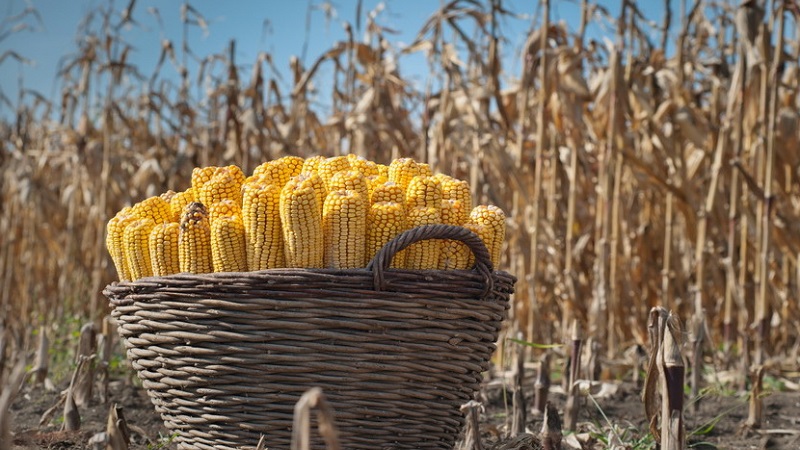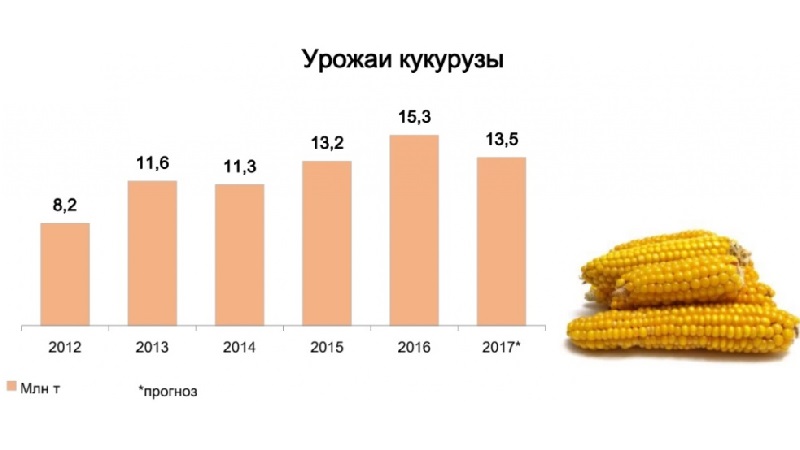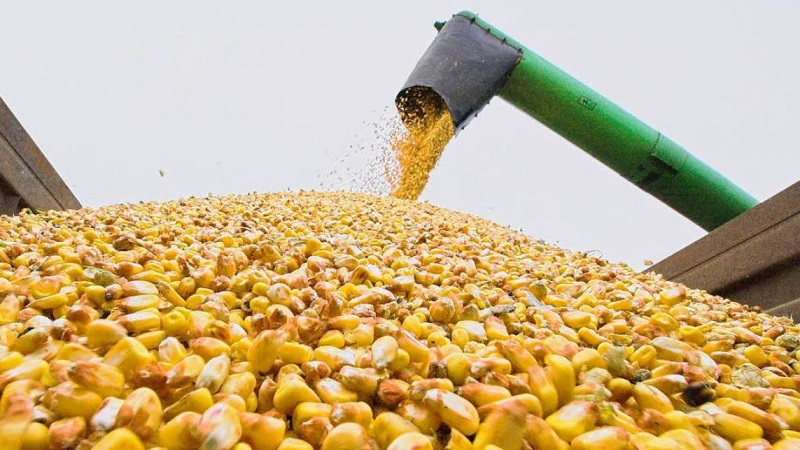What is the yield of corn per hectare: average, the influence of the type of variety or hybrid and other factors
Corn is one of the main Western crops. In European, and especially in American latitudes, this cereal plant is distinguished by its yield. In Russia, the cultivation of corn does not give such successful results, but with a competent approach, adherence to cultivation technologies and the selection of the most prolific varieties, you can get a good harvest.
The content of the article
What is the yield of corn per hectare
Corn more moody than many cultures, to which we are used to in the middle lane. This directly affects how fertile the plantings will be.

Growth phases
By the corn there are as many as six growth phases.
Emergence of seedlings
In good weather conditions this phase takes 7-8 days, in bad weather - 15-16 days... During this time, the aboveground mass of greenery is actively developing, but most of the resources are devoted to the growth of the root system.
The appearance of panicles
At this stage of cultivation, the largest increase in green mass is observed... In warm sunny weather, the dynamics can be up to 10-12 cm per day. The panicle is formed in different varieties differently:
- early maturing - at the stage of 4-7 leaves;
- mid-season - 5-8 leaves;
- medium late - 8-11 leaves.
Flowering ears
Also at this stage, threads are formed and pollination of pistils and stamens occurs... Flowering occurs in:
- early maturing - in the phase of 7-11 leaves;
- mid-season - 8-12 leaves;
- medium late - 11-16 leaves.
Corn will no longer grow green after flowering is complete, it will remain the same size as it was.
Milk state of grain
During this period, corn ripens up to 75%accumulating useful organic elements.
Milky-wax ripeness
The corn turns yellow and gets customary for the consumer view.
Wax ripeness
By the end of this stage cobs form the largest amount of dry matter.
Most important for determining yield the first 10-15 days before the emergence of shoots and the next 20 days before flowering and pollination of heterosexual plants. If bad weather falls at this time (rain, hail, frost, etc.), you should not expect a big harvest.
Average yield
In Russia, the average yield corn is 50-70 c / ha... According to official data, this indicator, however, does not go beyond the level of 35-45 c / ha, but this is already due to different climatic conditions in the country.

The reason for such low results may also lie in the fact that it is not customary in the Russian Federation to artificially irrigate corn fields., they feed only on the natural moisture of rain or groundwater. Corn irrigation farmers reported that they could receive up to 100-110 c / ha.
Important! It is difficult to talk about the average yield in the country, because different varieties and hybrids are used; besides, the climatic factor does not always allow to grow crops successfully.
If possible, it is recommended to check the statistics for your region. over the past years. By deriving the average over the last 3-5 years, you can get an approximate standard for your area or region.
How to calculate the approximate number using the formula
For a mathematical approach to calculating the potential grain yield, you need to make calculations in several steps:
Step 1. Determination of grain yield
Grain yield = 100 * Weight of grain / Weight of whole cob
This the formula helps you determine the percentage of grain-to-ear weight ratio and find out how much of the whole crop is suitable for consumption.
Attention! It can only be used for standard sowing of crops according to the scheme 70x35 cm.
Example... There is only one ear on one plant, its weight is 220 g, and its grain yield is 80%. This means that at a distance of 70x35 cm, its feeding area will be 2450 sq. cm or 0.245 sq. m.
Step 2. Dividing the sown area by the number of plants
Plant density per hectare = 10,000 sq. m / feeding area of 1 plant
Following our example: plant density per hectare: 10,000 sq. m / 0.245 sq. m = 40,890 plants per hectare.

Step 3. The final calculation of the mass of grain and ears
Ear yield = cob weight * number of plants per 1 ha
Grain yield = ear yield * grain yield / 100
Following our example:
Productivity of ears = 220 (g) × 40,000 = 8.8 t / ha;
Grain yield = Pack × W: 100 = 8.8 × 80: 100 = 7.04 t / ha.
Reference. Without first calculating the yield of the ears, you will not be able to obtain the yield of grain.
Factors that influence this
Among the main aspects of lowering corn yields are the following:
- Degree of infestation of fields by weeds, types of weeds. Particularly dangerous for corn are field thistle, tartar lettuce, field sow thistle, field bindweed, white gauze, common pikulnik, noticeable pikulnik, thistle thrown back, common barnyard, green bristle, hairy millet.
- Crop rotation - predecessor crops that were in this field in previous seasons, as well as the timing of their harvest. Of the good predecessors, winter wheat, legumes and melons, perennial grasses, potatoes, lupine, flax should be distinguished, from the bad ones - Sudanese grass, sorghum, sunflower.
- Relief. For growing corn the southern steppes are best suited.
It is recommended to plant corn in fields protected by forests on the north or north-east side.... As for the preliminary cultivation of the soil, regardless of what was grown and at what time, as well as for additional harvesting of weeds, it is necessary to carry out stubble cultivation twice with disc equipment to a depth of 8-10 cm.
Productivity of different types of corn
However the most significant factor is the choice of corn variety, because it directly determines the size of the future harvest.
Varieties and their yield
For Russian climatic conditions, early maturing varieties and hybrids are best suited... They have time to ripen even before the frost hits. The second advantage is higher yields than those of mid- and early-maturing crops.
As for the corn silage for animal feedthen it is best to plant mixed crops... They should be based on late-ripening varieties (for example, Russian bursting 3, Polaris, Bashkirovets) so that the greens are moist and juicy. Mid-season and early-maturing varieties and hybrids, including Brusnitsa, Maksaliya, Trophy F1, Jubili F1, Ladozhsky 191, besides silage, will also give good ears.
Hybrids and their yield
Experienced agronomists advise to decide in favor of hybrids, and not natural varieties. Since corn does not belong to the key crops of central Russia, hybrids are easier to adapt to the local conditions, since they are more resistant and unpretentious. Their yield, as a rule, turns out to be several times higher than that of conventional varieties..
The most productive varieties and hybrids
The highest-yielding varieties and hybrids in the Russian Federation include:
- Collective 160;
- Bemo 182;
- Dokuchaevsky 250;
- Corsair 315;
- Spirit;
- Gourmet 121.

Ways to increase it
To obtain the largest and highest quality harvest, it is necessary:
- Analyze the weather forecast for 3-4 months ahead. If there is no possibility, at least for 1-2 months, in order to prevent the most important stage of the emergence of sprouts and flowering of panicles from getting frost or rain.
- Choose the most suitable varieties for your region, giving preference to early maturing hybrids.
- Pre-treat the soil mechanically to get rid of weeds and residues from previous crops.
- Do not forget to also pre-fertilize with mineral and organic fertilizers. From organic food, as a rule, cow manure is used, mixed in water, in a ratio of 1: 5 at the rate of 60–80 t / ha; from inorganic - ammonium, potassium nitrate and superphosphate (8-12 kg / ha). All these fertilizers are applied to the soil after plowing and even before planting the seeds. To remove residual weeds and precursor crops, herbicides must be used before planting. For corn, the best suited preparations are "Prima", "Disulam", "Agent" (for dicotyledonous weeds), "Chester", "Monsoon", "Miladar" (for cereal weeds).
Conclusion
To successfully grow a corn crop, you need to pay particular attention to the following steps. Thorough soil preparation: removal of weeds and remnants of previous crops grown on the same site, as well as the introduction of complex fertilizers. Variety selection: If you are growing your own corn, choose early maturing varieties; if for livestock feed, combine early, mid and late ripening varieties. Try to choose the time for sowing in such a way that warm, sunny weather is guaranteed in the next month. Then the emergence of seedlings and flowering will take place in the most favorable conditions, because the volume of the harvest depends on this stage.